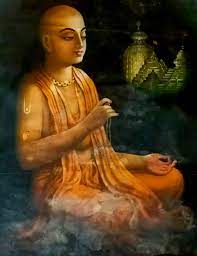Chaitanya Mahaprabhu is a revered figure in the realm of Indian spirituality and a central figure in the Bhakti movement. He is celebrated as a divine avatar of Lord Krishna who graced the earth during the 16th century. Chaitanya Mahaprabhu’s life and teachings have had a profound impact on the devotional traditions of India, especially within the Gaudiya Vaishnavism tradition.

Table of Contents
Early Life and Childhood of Chaitanya Mahaprabhu
Chaitanya Mahaprabhu was born in 1486 in the town of Navadvipa, located in present-day West Bengal, India. His birthplace is considered sacred by millions of devotees today. He was named Vishvambhara by his parents, Jagannath Mishra, and Sachidevi. From a young age, Vishvambhara displayed exceptional intellect and a deep inclination towards spirituality.
The Calling
At the age of 16, Vishvambhara experienced a divine revelation while bathing in the holy river Ganges. It is believed that during this sacred dip, he had a vision of Lord Krishna, which transformed his life. He felt a profound spiritual awakening and dedicated himself entirely to the path of devotion and spreading the divine love of Lord Krishna.
The Sankirtan Movement by Chaitanya Mahaprabhu
Chaitanya Mahaprabhu is perhaps best known for pioneering the Sankirtan movement, a devotional practice that involves the congregational singing and chanting of the holy names of God. He believed that by chanting the Hare Krishna mantra, people could attain spiritual enlightenment and experience a direct connection with the divine.
Teachings and Philosophy of Chaitanya Mahaprabhu
Chaitanya Mahaprabhu’s teachings emphasized the following:
Bhakti (Devotion)
He stressed the significance of pure devotion (bhakti) as the simplest and most effective means to attain God. Chaitanya taught that anyone, regardless of their background, could reach the divine through unwavering devotion.
Congregational Chanting
The practice of congregational chanting, particularly the Hare Krishna mantra (Hare Krishna, Hare Krishna, Krishna Krishna, Hare Hare; Hare Rama, Hare Rama, Rama Rama, Hare Hare), was central to his teachings. He believed it cleansed the heart and connected individuals with God’s grace.
Divine Love
Chaitanya Mahaprabhu emphasized the significance of divine love (prema) in one’s spiritual journey. He believed that love for God was the highest form of devotion and could lead to spiritual union with the divine.
Travels and Pilgrimage
After taking up the path of devotion, Chaitanya Mahaprabhu embarked on extensive journeys across India, spreading his teachings and the practice of congregational chanting. He visited various sacred places, engaging with people from diverse backgrounds and initiating them into the Sankirtan movement.
Lasting Legacy
Chaitanya Mahaprabhu’s legacy endures through the Gaudiya Vaishnavism tradition, which reveres him as the Supreme Lord. His teachings and the practice of congregational chanting continue to attract followers worldwide, and the International Society for Krishna Consciousness (ISKCON) has been instrumental in popularizing his message globally.
Conclusion
Chaitanya Mahaprabhu’s life and teachings exemplify the transformative power of devotion and the profound impact that one enlightened soul can have on the spiritual landscape of a nation. His legacy continues to inspire millions to seek a deeper connection with the divine through the practice of devotion and the chanting of the holy names of God. Chaitanya Mahaprabhu’s life is a testament to the enduring power of love, faith, and unwavering devotion on the path to spiritual realization.